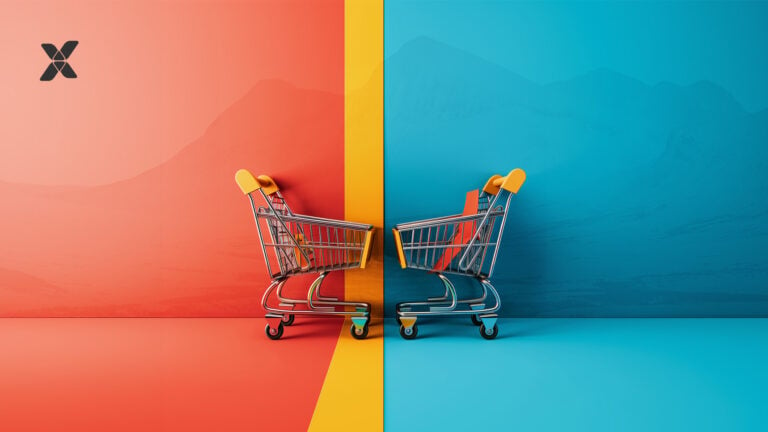As we officially begin the holiday season and the race toward all of the year-end “best of” lists . . .we didn’t want to be left out. But we also didn’t want to make just any old “trends” list, we wanted something that was more forward-looking . . . something that you could actually USE into the future. So, in this post, we’ll take a look at The Top 10 Ecommerce Future Trends.
What’s a Future Trend? It’s a trend that was firmly established in 2021 and is poised to continue (perhaps even accelerate) in 2022 and beyond. The pandemic created a tipping point for ecommerce and brands were suddenly under tremendous pressure to transform in order to move faster. Many of these trends took root in 2021 and are absolutely here to stay.
Let’s get to it.
10 KEY TRENDS IN ECOMMERCE
As businesses are gearing up to enter a post-pandemic world, two years of lockdowns and the perpetual threat of a fresh wave have reshaped people’s buying behaviors and significantly boosted ecommerce. Some of these habits are here to stay while others will morph into unique trends going into the next year. Below are our thoughts on what’s ahead.
10. Headless Ecommerce
If 2021 taught us anything, it’s that companies need to abandon outdated technology in order to remain competitive. An interconnected API-based architecture enables companies to do just that, by adapting without undergoing large-scale changes.
Described, headless is a term describing a concept where the frontend layer (the “head”) is separated from the backend layer (the “body”) This is done through application programming interfaces (APIs). In a traditional ecommerce structure, you are limited to using your particular vendor-provided ecommerce platform and wait for updates.
With headless ecommerce, the customer-facing part is separate and can thus be managed independently. In addition, headless architecture provides access to numerous third-party integrations to help meet your needs – and more importantly, the needs of your customers.
9. Grocery Ecommerce for Perishable Goods
In the pre-pandemic times, grocery retail suffered from a unique problem of short shelf lives and perishable products. With home deliveries directly from cold storages or even farms, grocery retail has received a facelift. Groceries were not only home-delivered but they were also delivered in record time, by local vendors– leading to both higher customer satisfaction and local business growth
In 2021, Grocery Ecommerce constituted 12.4% of all US ecommerce sales and this trend is here to stay because of its ease of access for customers, and scalability for ecommerce retailers.
Target grew its grocery ecommerce sales in 2021 to $6.04 billion by offering curbside pick-up for perishable products and excelled in the grocery ecommerce sector by targeting customer pain points and offering same-day grocery delivery.
Related Reading: 10 Things to Keep in Mind for Grocery Ecommerce Success
8. Flexible Payments and BNPL (Buy Now Pay Later)
Although just 7% of U.S. adults are very likely to use buy now, pay later (BNPL) services this holiday season according to eMarketer, Worldpay, estimates the growth of BNPL at a CAGR (compound annual growth rate) of 28%, and headed to $166 billion by 2023.
Additionally, the younger generations view BNPL as an alternative to traditional credit cards. Thus allowing them to buy trending merchandise without having to go all-in at the time of purchase. The percentage of Gen Z consumers in the US that use BNPL has grown from 6% in 2019 to 36% in 2021, and millennial consumers’ BNPL use has more than doubled in the past two years.
Now that certainly signals to us that there is some serious growth potential to this modern-day equivalent to “layaway.” And that this trend has nowhere to go but up.
Related Reading: Ecommerce Growth Through Flexible Payment & BNPL
7. Alcohol Ecommerce
Alcohol ecommerce has grown in almost every market this past year. Even in the U.S., where regulations previously have held back the digital transformation of this industry, the online wine and beer business is booming.
Additionally, the U.S. is today on track to become the biggest alcohol ecommerce market by the end of 2021. Not surprisingly, research shows that almost half (44%) of the people in the U.S. who purchased alcohol online this year were first-timers.
At the core, buying alcohol online isn’t that different from other fast-moving consumer goods. And customers’ expectations related to the experience are very much the same for alcohol as for buying groceries or electronics. Here are 4 essential insights that alcohol brands should leverage:
PEOPLE PREFER DIGITAL SHOPPING
COVID-19 forced us all into a rapid digital adoption. But forced or not, during the past year, many have come to realize they actually prefer the convenience of picking out their wine from the couch, and most people have now fully embraced the new, digital way of doing things.
PERSONALIZATION IS KEY
When people start buying alcohol online, they’re already accustomed to highly personalized and seamless shopping experiences from purchasing other types of goods. So while the alcohol industry is relatively new to the digital scene, it’s essential to deliver the level of personalization and service that consumers have come to expect online elsewhere.
ECOMMERCE REQUIRES DIGITAL MARKETING STRATEGIES
Alcohol brands will need to reinvent their branding and marketing strategies and adapt to the digital way of selling. Before, most people bought wine and spirits in physical stores, but those days are history. This rapid transformation requires brands to innovate and evolve to stay relevant and visible.
FIRST-PARTY DATA WILL HELP YOU WIN
By adopting a digital-first mindset and building a solid infrastructure for collecting and leveraging first-party data, alcohol brands will be able to make giant growth leaps. This is a race where the most digital-savvy businesses will see great returns, and those who keep doing things the old way will risk being left hopelessly behind.
Related Reading: Alcohol Ecommerce: 2021 Trends, Strategies, And Markets
|
Want more advice on this topic? |
6. Linear Ecommerce – Starting With the Audience
For a product to be purchased, there must first be an audience who wants or needs it.
Based on this fundamental of business, linear commerce flips the normal cycle of creating a product, marketing to an audience, and selling said product on its head.
Instead, this approach focuses on the audience first and products second. This unique approach is changing how new companies are birthed and is causing existing businesses to rethink how they acquire customers.
Once the audience understands the foundation of your product, they are more convinced to buy from you. Secondly, using organic engagement methods helps ecommerce retailers to understand their customers better and tweak the product accordingly before releasing it.
Related Reading: Linear Commerce: What it is and Why it’s Important
5. E-tailing vs Ecommerce
E-TAIL: A DEFINITION
- E-tailing is short for electronic retailing and refers to the specific activities related to selling retail products and services via the internet. The key words in this definition are “retail products and services.”
ECOMMERCE: A DEFINITION
- Ecommerce refers to a broader set of activities that include but are not limited to: selling retail products on the Internet (e-tail), electronic financial services like online transfers or transactions, management of online supply chains, mobile commerce (mCommerce), digital marketing, data collection systems, and more.
While some would argue that e-tail and ecommerce are just different words for the same thing, others claim that there are some important differences between the two concepts. Whether you consider those differences to be mere semantics or not, thinking about them may actually be a great entry point to more significant strategic discussions and decisions for your business.
Related Reading: E-Tail Vs. Ecommerce – What’s the Difference?
4. Multi-Brand Strategies for Serving Different Demographics
In the ecommerce space, a multi-brand strategy includes the trifecta of Commerce, Content, and Community. Creating a community, harboring their inputs, and adding value to their lives through content takes time and constant effort to build. Brands utilize this customer base and community to launch relevant products either using a Branded House or House of Brands strategy.
If your business includes more than one brand, understanding the pillars of digital commerce in a multi-brand strategy will be crucial to building your sales and marketing strategy. The best structure for your company depends on many factors, and it is helpful to begin by distinguishing between the two main types of multi-brand strategies: Branded House vs. House of Brands.
Related Reading: Multi-Brand Strategies–Branded House Vs. House Of Brands
3. Phygital Experiences
Yes, it’s hard to say and reminds me more of making small nervous movements with one’s hands and feet than it does anything related to marketing or ecommerce. But perhaps I am being too harsh and there is a need to revisit this “mash-up” of ideas, channels, and touchpoints.
A combination of the physical and the digital, phygital experiences promise the best of both worlds. Adding wearable tech, interactive product descriptions, livestream ecommerce, QR codes, and even animation to digital apps, sites, and experiences are a few of the ways future thinking ecommerce operators are adding a navigable experiential quality to their platforms.
The delivery of a coupon with a QR code when you order from an online brand is an example of a phygital experience. While you’ve ordered a physical product, you get a scannable coupon with a QR code. When you scan this it will show you your discount options, a way to convert the coupon into loyalty points or exchange it for an accessory product on the company’s website.
A phygital experience could also be introduced the other way around. You could go to a store, try on a pair of sneakers, and then be offered a VR headset that allows you to see it in different colors or perhaps a different environment.
Phygital experiences amplify both in-person and online shopping experiences.
Related Reading: What is a Phygital Experience? 6 Real-World Examples
2. Dark Stores: A Post-Pandemic Retail Model
While the term ‘Dark Store’ may sound like a Halloween spin on retail stores, it is actually an ingenious solution to the hybrid post-pandemic world. Dark Stores refer to brick-and-mortar stores that get turned into storage spaces to hold larger amounts of inventory.
Dark Stores offer their customers the benefits of in-store pick-up, same-day delivery, and quicker exchange. Think of it as a segment of inventory warehouse in a retail location with the advantages of massive inventory storage as well as the ability to invite customers.
Since Dark Stores cut down delivery times by storing inventory closer to the delivery location, this trend is here to stay. Famous brands that went all-in on dark stores include retailers such as Whole Foods, Walmart, and Target.
Related Reading: What is a Dark Store? A Post-Pandemic Retail Model
1. Supply Chain Issues Remain a Challenge
As the economy emerges from the worst pandemic in a century, getting enough products to consumers continues to be THE most daunting challenge for nearly everyone. This trend is not going away anytime soon and our belief is that we are just at the beginning of a major shift in the Global Supply Chain.
How Vaimo Can Help
Brands that strategically adapt to the changing market winds will break through, and as the world enters a post-pandemic new normal of digital, physical, and metaphysical, brands that innovate in keeping with ecommerce future trends will chart new paths.
Navigating the different options and implementing new business models can feel overwhelming.
At Vaimo, we have extensive experience in helping clients take their online businesses to the next level. And as always, the key to getting ahead is getting started.








